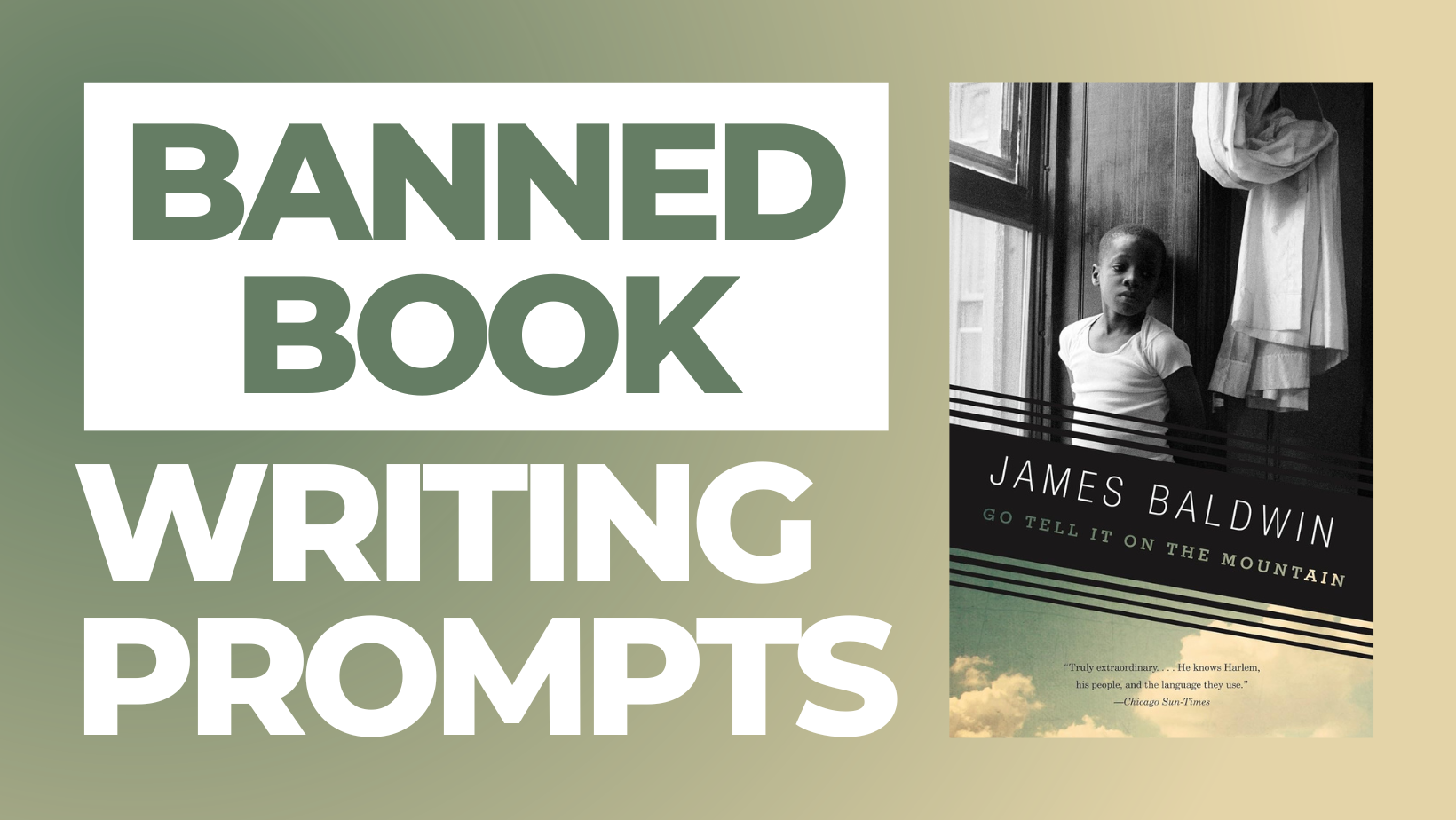This article previously appeared in Teachers & Writers Magazine, Volume 29, Issue Number 3, Jan-Feb 1998.
Of course I don’t wish to dilute their human feeling for this person who has suffered and witnessed great suffering; but I want them to understand the mastery of language that Baldwin accomplished, because this is part of the positive side of the ledger that helped him survive—and may help them survive.
Whenever I have used personal essays to motivate students to write their own, I have relied on James Baldwin’s work, because I know that he will get high school and college kids engaged and excited. The resistances they show to Lamb, Hazlitt, Montaigne, and all those other “old-timey writers” seem to melt away under Jimmy’s fiery gaze. It is Baldwin to the rescue, in part because his honesty and passion are very attractive to young people; but also because Baldwin dramatized adolescence again and again as his own particular crucible of selfhood—boy preacher, loss of faith, yearnings to write, father’s death, foregoing college, struggles over racial anger and sexual preference—and sympathized so warmly with the efforts of all youth to forge an identity.
In an essay entitled “They Can’t Turn Back,” on the desegregation of the schools in the South, he writes, parenthetically and characteristically, about the “really agonizing privacy of the very young. They are only beginning to realize that the world is difficult and dangerous, that they are, themselves, tormentingly complex and that the years that stretch before them promise to be more dangerous than the years that are behind. And they always seem to be wrestling, in a private chamber to which no grownup has access, with monumental decisions. Everyone laughs at himself once he has come through this storm, but it is borne in on me, suddenly, that it is a storm, a storm, moreover, that not everyone survives and through which no one comes unscathed. Decisions made at this time always seem—and, in fact, nearly always turn out to be—decisions that determine the course and quality of a life. I wonder for the first time what it can be like to be making, in the adolescent dark, such decisions as this generation of students has made.”
This is catnip to the young.
I am being a bit ironic because, while I love Baldwin’s writing, I sometimes feel that I have to exert counterpressure to pry students from its appeal and exercise a little critical intelligence. Once they fall under the spell of his voice, they tend to buy into his whole analysis of race, politics, America—the bombastically prophetic, wrongheaded parts as well as the sensible. What they really buy into is his presentation of self as a wounded being: there can be no doubt that, in a talk-show culture that enshrines victimhood, Baldwin plays exceedingly well.
When I teach Baldwin I focus on his essays, because I think he is a great essayist—indeed, the most important American one since the end of World War II—and only a so-so fiction writer. His long novels, Another Country and Just above My Head, now seem windy and unfocused; Giovanni’s Room, precious. When there is enough time, I have occasionally assigned Go Tell It on the Mountain, which many consider his best, just to show how the same material (a Harlem adolescence) may be treated via both fiction and non-fiction. To my mind, this first novel of Baldwin’s, atmospheric but clotted, cannot hold a candle to his infinitely more expressive personal essay, “Notes of a Native Son.”
A twenty-page miracle, a masterpiece of compression, “Notes of a Native Son” seems to pour out in a white-heat of emotional prose, though it is everywhere artfully shaped. The portrait of his father, David Baldwin (whom he later learned was actually his stepfather), is a model of unsentimental ambivalence. Many students, encountering it for the first time, are shocked to see that one can actually tell such tales out of school. Baldwin’s ferocious and fastidious candor liberates them to begin writing about the meanings of their parents’ lives.
I generally focus on the following amazing paragraph:
He was, I think, very handsome. I gather this from photographs and from my own memories of him, dressed in his Sunday best and on his way to preach a sermon somewhere, when I was little. Handsome, proud, and ingrown, “like a toenail,” somebody said. But he looked to me, as I grew older, like pictures I had seen of African tribal chieftains: he really should have been naked, with warpaint on and barbaric mementos, standing among spears. He could be chilling in the pulpit and indescribably cruel in his personal life and he was certainly the most bitter man I have ever met; yet it must be said that there was something else in him, buried in him, which lent him his tremendous power and, even, a rather crushing charm. It had something to do with his blackness, I think—he was very black—with his blackness and his beauty, and with the fact that he knew that he was black but did not know that he was beautiful. He claimed to be proud of his blackness but it had also been the cause of much humiliation and it had fixed bleak boundaries to his life. He was not a young man when we were growing up and he had already suffered many kinds of ruin; in his outrageously demanding and protective way he loved his children, who were black and menaced, like him; and all these things sometimes showed in his face when he tried, never to my knowledge with any success, to establish contact with any of us. When he took one of his children on his knee to play, the child always became fretful and began to cry; when he tried to help one of us with our homework the absolutely unabating tension which emanated from him caused our minds and our tongues to become paralyzed, so that he, scarcely knowing why, flew into a rage and the child, not knowing why, was punished. If it ever entered his head to bring a surprise home for his children, it was, almost unfailingly, the wrong surprise and even the big watermelons he often brought home on his back in the summertime led to the most appalling scenes. I do not remember, in all those years, that one of his children was ever glad to see him come home. From what I was able to gather of his early life, it seemed that this inability to establish contact with other people had always marked him and had been one of the things which had driven him out of New Orleans. There was something in him, therefore, groping and tentative, which was never expressed and which was buried with him. One saw it most clearly when he was facing new people and hoping to impress them. But he never did, not for long. We went from church to smaller and more improbable church, he found himself in less and less demand as a minister, and by the time he died none of his friends had come to see him in a long time. He had lived and died in an intolerable bitterness of spirit and it frightened me, as we drove him to the graveyard through these unquiet, ruined streets, to see how powerful and overflowing this bitterness could be and to realize this bitterness now was mine.
Perhaps what finally makes him so attractive to young people is the way he epitomizes the process of becoming a man, without losing touch with, or falsifying, the part of himself that remains a very vulnerable boy.
It’s all there, in this paragraph, but it requires some unpacking: Baldwin’s sheer love of language; his intoxication with adjectives and adverbs, at a time when others avoided them; his Biblical rhythms, oral-sermon repetitions and series syntax (“and . . . and”); his oxymorons (“crushing charm”); his witheringly undercutting use of subordinate clauses (“never to my knowledge with any success”); his anglicisms (“rather” or the impersonal pronoun “one”); his verbal arrows and pointers (“yet it must be said that,” “therefore”); his ability to sustain an extremely long sentence without wearying or confusing the reader; his willingness to pull back from a specific detail and make a broader generalization; his balance between rejection and tenderness, between rage and forgiveness; his ennoblings and deflations, often in the same sentence; his detachment and grim humor; and finally, his generous move to identify with, show complicity with, the sin (“this bitterness”) he had seemed to be indicting.
Baldwin’s prose is a carefully crafted, highly mannered (in the best sense) performance, and some of what I do when I teach him is to draw attention to his techniques. Students tend to inhale powerful prose in an undifferentiated rush, and I want to slow them down. Of course I don’t wish to dilute their human feeling for this person who has suffered and witnessed great suffering; but I want them to understand the mastery of language that Baldwin accomplished, because this is part of the positive side of the ledger that helped him survive—and may help them survive.
I ask them to write a portrait of their mother or father, and to reflect on how we take on the traits of our parents, for better or for worse. Or I ask them to write about some incidents in which anger got the better of them, or to consider in an essay the nature of bitterness. Or just write about their growing up. By the time they have finished reading “Notes of a Native Son,” they have often gotten the point—the challenge to be as honest and personal as possible on the page—and don’t need much specific prodding to be off and running.
I follow it with as many Baldwin essays as I can, because I find that he is one of those writers whom students are willing to be saturated by. The more they read him, the more comfortable they become with his strategic moves and range of interests, and the more he seems a friend. Ideally, I can assign as a text the fat, collected book of Baldwin nonfiction, The Price of the Ticket, though one can also get by in a pinch with the earlier, paperback collections such as Nobody Knows My Name and The Fire Next Time, which are still in print. I ask them to read such gems as “Equal in Paris” (a narrative vignette about his getting arrested), “Stranger in the Village” (a meditation on otherness and the expatriate experience), “The Harlem Ghetto” (just to show how fully formed a stylist he was at twenty), “Alas, Poor Richard” (a searching double portrait of Baldwin and his patriarchal mentor/rival, Richard Wright); “Sweet Lorraine” (about the playwright Lorraine Hansberry), and, of course, “The Fire Next Time.”
This last, full-length essay has portions as great as anything Baldwin ever wrote. You may have to supply a certain amount of historical context for students (the mood of the sixties, the civil rights movement, the Black Muslims, etc.), though I have found, on the whole, that they get it. A bigger problem is the one I alluded to earlier: when this ambitious conglomeration of an essay begins to fall apart, the rhetorical smoothness of Baldwin’s writing may fool students into not even questioning his apocalyptic overkill (such as that if America doesn’t support revolutions abroad and at home, it will be burned to the ground).
The full-length essays that Baldwin continued to write, such as “No Name in the Street” or “The Devil Finds Work,” are fascinating to teach—partly because they have such wonders in them and partly because they don’t really hold together. (It’s salutary, I think, for students to realize that the structural problems of essay writing may be so daunting when the ante is raised that even a master of the form can get bogged down.) In one sense the long, long essay was Baldwin’s form: it brought out relaxed, self-surprising passages in him that nothing else did. But in another sense, he never figured out how to pull it off artistically, how to tie up the loose ends or give it an inevitable shape. This may have as much to do with the essay form today as with any inadequacies on Baldwin’s part.
There are lessons anyone attempting to write personal essays can learn from Baldwin. How to dramatize oneself, for instance. Most personal essays misfire because of the blandness of the narrative persona, but this was never a problem for James Baldwin; he could always project himself on paper as in the midst of some burning conflict or dire strait. He was a bit of an actor, which an essayist needs to be—willing and able to take on one mask or another.
Another of his admirable qualities was a self-reflective insight that let us into his thinking process. Six pages into “Alas, Poor Richard,” we encounter this passage:
I was far from imagining, when I agreed to write this memoir, that it should prove to be such a painful and difficult task. What, after all, can I really say about Richard . . ? Everything flounders in the sea of what might have been. We might have been friends, for example, but I cannot honestly say that we were. There might have been some way of avoiding our quarrel, our rupture; I can only say that I failed to find it. The quarrel having occurred, perhaps there might have been a way to have become reconciled. I think, in fact, that I counted on this coming about in some mysterious, irrevocable way, the way a child dreams of winning, by means of some dazzling exploit, the love of his parents.
I began by implying that James Baldwin had in some ways been fixated on his adolescent crisis and had overacted the part of the racial victim. But we see from this passage how incomplete my assessment was; for it demonstrates the worldly, sorrowful realism and willingness to take responsibility for one’s fate that makes Baldwin, at his best, a hero of American maturity. Perhaps what finally makes him so attractive to young people is the way he epitomizes the process of becoming a man, without losing touch with, or falsifying, the part of himself that remains a very vulnerable boy.
Bibliography
Baldwin, James. The Fire Next Time. New York: Dell, 1985.
Baldwin, James. Nobody Knows My Name. New York: Dell, 1978.
Baldwin, James. The Price of the Ticket. New York: St. Martin’s/ Marek, 1985.
Phillip Lopate's many books include Being with Children, Bachelorhood, and Portrait of My Body. He is also the editor of The Art of the Personal Essay and the new series, Anchor Annual Essays. Lopate teaches at Hofstra University.



